Are you a Quiet Speculation member?
If not, now is a perfect time to join up! Our powerful tools, breaking-news analysis, and exclusive Discord channel will make sure you stay up to date and ahead of the curve.
As of late, I've talked about the various types, mentalities and trends you see associated with the Magic Finance world. Altitude being a thing, grasping some concepts might be harder for those more recently exposed to the world of Finance than for others. When I refer to altitude, I'm speaking of some of the deeper principals that effect every single aspect of what we do.
For example, Magic Finance is considered a force all it's own. This force is wild, fickle, and changes with the most subtle of winds. It's easy to get lost in the “If's” of it, and lose focus on the “When.” Newer people will often lose track of cards that go through many phases, many “if this happens” type scenarios. If you focus less on that, and first start off with the card on it's own, in a vacuum so to speak, you will notice a trend that is much easier to predict. Often times with so many Insiders and Speculators and Stores getting savvy – a card will double or triple in value, almost over night. You hear “That card is insane.” and “I can't believe it was so cheap.” long after it's price jumped. The savvy Insider was ahead of all of this, though. For if you have correctly assessed the power level of a card, then you are simply waiting for the financial level of a card to move.
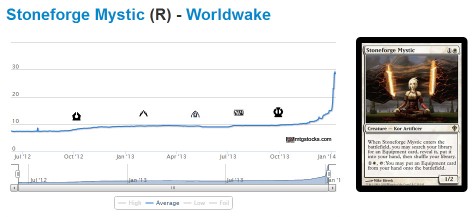
Stoneforge Mystic is currently in such a swing. The card has spent months sitting on retail sites at a fraction of what similar power level cards retail at. The card performs well and yet often the price of the card does not move. In a vacuum, it's easy to tell that Stoneforge Mystic is inherently powerful in what it does. It also sees play in multiple formats and is so good it's banned from what I hear. Often times we wait for a breakout weekend to force a card to move, but what if there is never the breakout tournament? Often times their are whispers of a deck doing well, followed by a sudden shift in what everyone thinks about a card. Overnight, it goes from "Zero to Hero." If that happens, you've got to be in the door fast. The maximum level of profit and accessibility to copies of that card typically is gone in a heart beat. It's a mad dash for your closest game store, online retailer, or eBay seller.
Where's the Secret Entrance?
As a store – I must take the long view approach on everything I do. Sacrificing current sales, to ensure that when a card takes off, I have the copies available is vital to my success. Finding the power level of a card is the key. In the context of playing this game, everyone can agree there are some inherently powerful cards. Stoneforge Mystic has been repressed in value mainly because everyone felt it was “too new.” That there were too many cards in circulation and that rotation had happened too recently. There is never a time where a card is too new to rise in value. All it takes is for one flash in the pan, and everyone will follow suit.
For that – let's take a look at Misty Rainforest and Scalding Tarn:
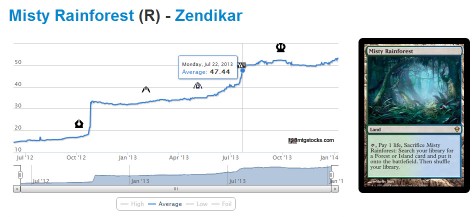
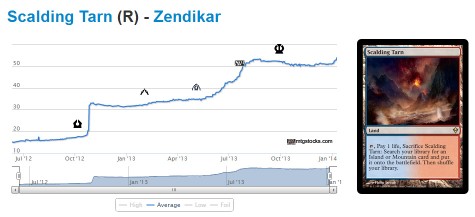
Post-rotation, the feeling was that most Zendikar Fetch Lands were a good long term investment, but up to that point – nothing like what would happen had occurred on such a public scale. The flash in the pan happened, changing every person's mentality on what this card could do fincially. The power level had already been figured out, and it was correctly assessed as being very powerful. What made the difference? A buyer came in a decided they wanted to corner the market. Thus, creating a great shortage of supply. Months later, the full effect of that mentality shift can be felt. No one wants to let go of Blue Fetch Lands. The stock is considered a “high hold.” A card that is doing nothing but climb in value. All it took to change that was one store setting the pace.
What's Next:
Currently, one of the things that are rarest to find – is the ability to outright destroy a Planeswalker. Most popular Planeswalkers are built to protect themselves in some fashion. These range from increasing it's loyalty on the first activation to preventing damage and more. If we want to talk about cards that are correctly assessed as very powerful then we have to look no further than Standard itself. There, alone, lie three prime examples of multi-format All Stars that are now just waiting for the “When.” WotC has not made it a habit of giving the ability to out right destroy a Planeswalker. Each one has it's own context for taking off, and each one is poised for significant gains in multiple formats.
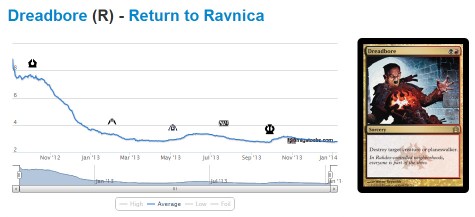
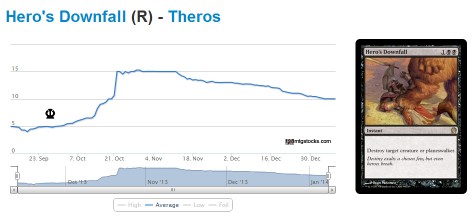
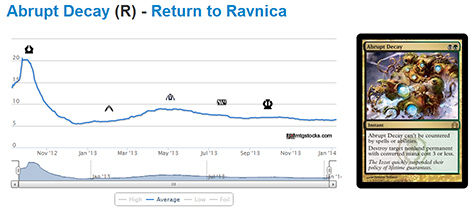
On their own, each card is currently repressed in value. Mainly because of being viewed as readily available. Right now, these examples are just waiting for their moment to shine. Once the perspective changes on what these cards are financially capable of doing, then the price will reflect itself in the market. Too often, most stores read and react to these winds of change. They normally will not wait for the “When” moments as often times a new seller will come in on any random day of the week, and their current value for that card will still be profitable for them. For you, that's hard to accomplish. Focusing on when the card is the lowest and perception of the card is incorrect, will allow you to be ahead of the curve, when the opportunity finally does present itself.
This takes patience, fortitude, and accuracy in how you judge cards. The subtle change in mentalities will eventually effect these cards, and if you've put yourself in the correct position, they will pay massive dividends. All it takes is just a change in the wind and for you to already be locked and loaded.
Till next time.
- Dylan




I definitely like where you were going with this article. I think the biggest problem currently is there’s not quantitative way to analyze “power level”. Everyone just agrees that fetchlands are way more powerful than evolving wilds, but they do very similar things. There is no # to assign to the abilities to show that they are more powerful and how much more powerful they are. I do believe that the cards you highlighted in What’s Next are also plagued by a glut in the supply (less so than everyone’s assumption that they are readily available). The past few sets have been opened in much larger amounts than previous sets (as the player base has grown quite impressively the past few years) and the # of these cards per player who wants them is much higher than cards printed say 4 years ago or so. The other issue with your picks are that they are all removal (granted that’s due to the choice of “what kills a planeswalker” requirement), but it’s important to keep in mind that there have very rarely been rare 1 for 1 removal spells and those that are usually included another caveat where the caster got something else tacked on. The mindset from the playerbase has always been that 1 for 1 removal spells are usually common or uncommon, so the price may be hampered by that mentality. Abrupt Decay is the outlier and that one I think is the best bet on your list as it’s played in all formats currently.
I agree on the need for a quantifiable system of evaluation. If we had a number based system for non-creatures, it would make a world of difference. Creatures are easy: a 1/1 for 1 mana has been a baseline for creatures. Previously, cards like Juzam Djinn were considered op because they broke that formula. A 5/5 for 4 mana was considered good because it eliminated the need for 2 of its colored mana and dropped one required mana entirely. Deathrite Shaman is considered good now because it adds so much more to that formula. A 1/2 for one mana isn’t enough these days to inspire a rush. Making the mana flexible, then adding 3 relevant abilities is what makes the math so good.
Basically, the old school baseline breakdown went as follows:
Every 1 colored mana was replaceable with 1.5 colorless
Every 1 colored mana got 1/1, so a 3/3 for 3 colored mana was baseline
Each ability added cost 1 colorless
Multiple colors made a decrease in mana at a ratio of 4:3
Using this guideline, you can assess most creatures. A Hill Giant: 3/3 for 3R with 0 abilities reads as follows:
3 colorless =2 colored, plus one colored = 3 mana. A 3/3 for 3 colored mana with 0 abilities makes a baseline, or +0, creature. Not too good.
Now lets evaluate something like Deathrite Shaman:
1 flexible mana = +0.25. A 1/2 body for 1 mana can be seen as a +0.50 for the toughness, making a total of +0.75. Still not good enough to see demand. Now lets tack on 3 relevant abilities: +3. So now we have a +3.75 above baseline. I would say that is good.
Finally lets evaluate something more difficult, RUbblebelt Raiders:
The hybrid mana on them counts as 2.5 colored mana, plus another 0.5 for the colorless. So you get a baseline creature or 3/3 for 3. It also has one ability, making it a real +1. So +0 for mana conversion and +1 for an ability makes it only +1. Not too great in my eyes.
Finally, we will have to quantify what each ability is actually adding. We have a baseline of +1 per ability. We need to modify that using careful analysis of each metagame. If white removal dominates, Wildfire Emissary’s “protection from white” will be rated higher than a Whirling Dervish’s “protection from black.” So we have to create an extensive list of what the baseline evaluations are for each creature in each format. Then we need to adjust our baselines to reflect what each additional ability is really adding. Deathrite is a backbreaker in Legacy because all his abilities impact the metagame so profoundly.
In conclusion, I would state that we need to list each effect applicable to creatures and spells in a mathematical formula. I propose the first rule to be that drawing 2 cards takes 2.3 mana (Divination costs 2U, making 0.666 + 0.666 + 1 = 2.332). This makes Ancestral Recall worth a total of ~7 (an actual gain of +5.3). It would be nice to quantify all effects and abilities in such a fashion. Then we (as a community) could figure out modifiers for each format.
I would also like to add that I am terrible with math, so if any of my equations are off, please be gentle. These are actual methods I use to evaluate cards. I made up the numbers trying to figure out the methods used by WotC. They are not meant to be 100% accurate, just a reference point. We could reverse engineer the formulas actually used by r&d with more data and more minds applied.
Sorry for the essay,
Jesse Williams
Lost Coast Wizards
Arcata, CA
This is a really interesting way of thinking Jesse, I like where you’re going with it and would love for you to expand on these ideas. I think the weakness though is that it doesn’t take into account the metagame. Cards like Spellskite (first example I can think of) break this formula because they can be great meta calls: if you know that your meta is full of Jund and UWR then Spellskite becomes more powerful.
I think SFM is a bad example, since I see a big part of it’s price change being based on TNN being printed. People realized the interaction, and a new price point was set based on an uptick in demand. That card started spiking the minute people saw TNN.
Tim, I disagree with your point, financially the retail and market value margin for SFM was 0% to -15%. His point is right on them money, TNN just let the public realize the true price point for SFM.